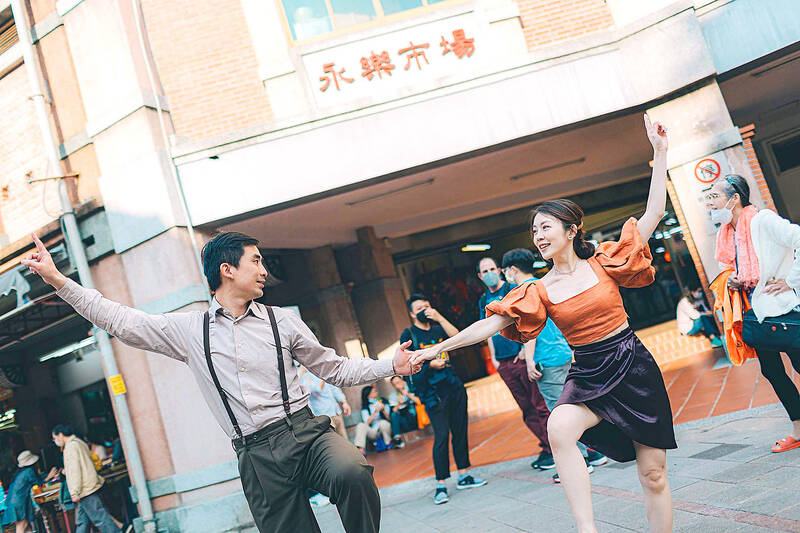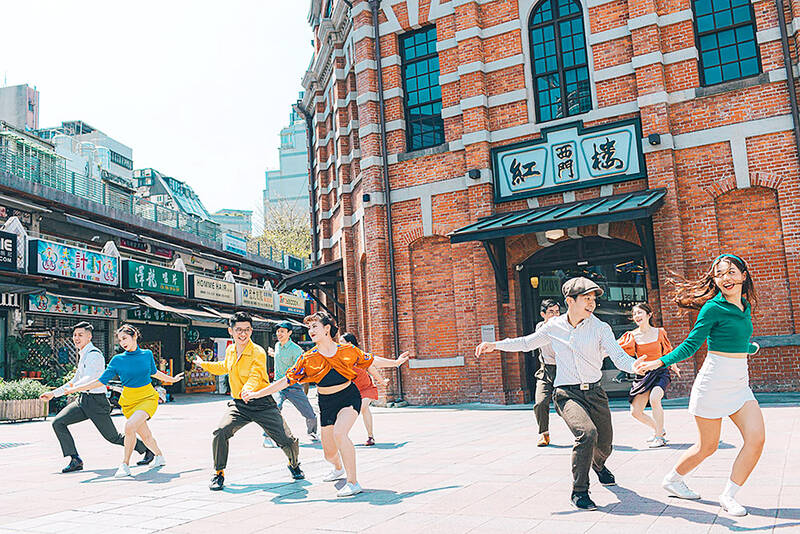Swing your way through old Taipei as the Bubble Pop Lindy Exchange kicks off today for a three-day dance and music extravaganza with an infusion of local culture and history. Visitors will get to take dance lessons, watch professional performances, shop at vintage and food markets, attend seminars and go on cultural tours of historic neighborhoods.
Established swing dance groups from across Taiwan will converge in the capital to share their expertise with attendees and dazzle them with their moves. Live bands such as TPO (踢霹歐), Lady & Knight (女爵騎士), the Flat Fives and the Lin Liang-yu Trio (林亮宇爵士三重奏) will provide the lively soundtrack, and TPO band leader Jim Geddes will offer a seminar about the history of jazz.. Sing Yuen Lim, a dance veteran of 30 years, will share her experiences and rich knowledge of swing dancing.
Popular walking tour group Like It Formosa will take people back in time, visiting sites such as Bopoliao (剝皮寮), Nishi Honganji Temple (西本願寺), Yongle Market (永樂市場) and the Railway Department Park (鐵道部園區).

Photo courtesy of Bubble Pop Lindy Exchange
The main event of each night is the dance party at the Red House Theater, which will rage on until 1:30am. Keep note of the dress codes for each day.
■ Most events are free at the Red House Theater’s north plaza, 174, Zhonghua Rd Sec 1, Taipei City (台北市中華路一段174號). The dance party is on the second floor of the building, admission is NT$1,400 per night and NT$4,500 for three nights
■ Today through Sunday, for full schedule visit www.bubblepop.tw

Photo courtesy of Bubble Pop Lindy Exchange

Photo courtesy of Bubble Pop Lindy Exchange

In the March 9 edition of the Taipei Times a piece by Ninon Godefroy ran with the headine “The quiet, gentle rhythm of Taiwan.” It started with the line “Taiwan is a small, humble place. There is no Eiffel Tower, no pyramids — no singular attraction that draws the world’s attention.” I laughed out loud at that. This was out of no disrespect for the author or the piece, which made some interesting analogies and good points about how both Din Tai Fung’s and Taiwan Semiconductor Manufacturing Co’s (TSMC, 台積電) meticulous attention to detail and quality are not quite up to

April 21 to April 27 Hsieh Er’s (謝娥) political fortunes were rising fast after she got out of jail and joined the Chinese Nationalist Party (KMT) in December 1945. Not only did she hold key positions in various committees, she was elected the only woman on the Taipei City Council and headed to Nanjing in 1946 as the sole Taiwanese female representative to the National Constituent Assembly. With the support of first lady Soong May-ling (宋美齡), she started the Taipei Women’s Association and Taiwan Provincial Women’s Association, where she

Chinese Nationalist Party (KMT) Chairman Eric Chu (朱立倫) hatched a bold plan to charge forward and seize the initiative when he held a protest in front of the Taipei City Prosecutors’ Office. Though risky, because illegal, its success would help tackle at least six problems facing both himself and the KMT. What he did not see coming was Taipei Mayor Chiang Wan-an (將萬安) tripping him up out of the gate. In spite of Chu being the most consequential and successful KMT chairman since the early 2010s — arguably saving the party from financial ruin and restoring its electoral viability —

It is one of the more remarkable facts of Taiwan history that it was never occupied or claimed by any of the numerous kingdoms of southern China — Han or otherwise — that lay just across the water from it. None of their brilliant ministers ever discovered that Taiwan was a “core interest” of the state whose annexation was “inevitable.” As Paul Kua notes in an excellent monograph laying out how the Portuguese gave Taiwan the name “Formosa,” the first Europeans to express an interest in occupying Taiwan were the Spanish. Tonio Andrade in his seminal work, How Taiwan Became Chinese,